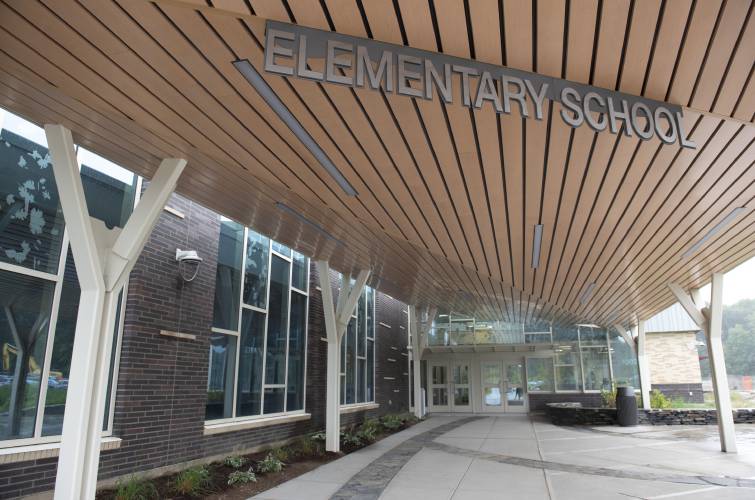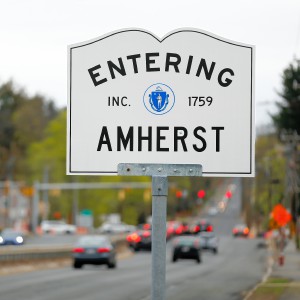Easthampton schools adopt $22.8M budget with no layoffs; enrollment decline, student needs a concern

Mountain View School elementary entrance in Easthampton. FILE PHOTO
| Published: 03-27-2025 1:35 PM |
EASTHAMPTON — Grappling with both lower enrollment and higher levels of need among students, the Easthampton School Committee approved its $22.8 million fiscal year 2026 budget on Wednesday night.
The budget maintains level services for the district and presents a 10.25% increase in spending compared to the current year. Unlike many other area districts, Easthampton did not have to make staffing cuts. But similar to its neighbors, Easthampton is facing “flat” state aid in the form of Chapter 70 funding, as well as uncertainty around federal funding for programs such as free school breakfasts and lunches.
“This is not a hugely aspirational budget,” said School Committee Chair Laura Scott during the budget presentation. “This is a level service budget.”
The Easthampton Public School District has decreased by more than 170 students since the onset of the COVID-19 pandemic, but the number of students identified as having “high needs” has increased since then. While a lower number of students can make securing funding more challenging, and addressing the heightened needs of the student body can drive costs up, Scott explained during Wednesday’s budget presentation that this is “not an Easthampton phenomenon.”
Julia Saari-Franks, director of business services for the district, emphasized that point, saying that this phenomenon is being witnessed statewide — but goes largely unaddressed by the Chapter 70 funding formula. For fiscal year 2026, Easthampton is slated to receive $8.9 million in Chapter 70 funding, which is an increase of roughly $117,000 from this year.
Both Scott and Saari-Franks remarked that this increase does not keep up with inflation or student need.
Additionally, in closing out fiscal year 2025, the district’s current projections indicate a budget deficit of $1.1 million, which they are exploring options for covering. Interim Superintendent Maureen Binienda explained that this deficit came largely from unexpected costs surrounding the needs for special education students, especially out-of-district transportation and tuition.
For fiscal 2026, which begins July 1, Saari-Franks explained that “most of the increase in the budget is personnel.”
Article continues after...
Yesterday's Most Read Articles
 Northampton Housing Authority boss placed on leave
Northampton Housing Authority boss placed on leave
 NCAA Div. 1 Men’s Ice Hockey: UMass stuns Minnesota 5-4 in OT, advances to regional final
NCAA Div. 1 Men’s Ice Hockey: UMass stuns Minnesota 5-4 in OT, advances to regional final
 UMass Men’s Basketball: Three Minutemen enter transfer portal
UMass Men’s Basketball: Three Minutemen enter transfer portal
 Putting themselves on the line: Activists say nonviolent protests focus attention, inspire others, drive change
Putting themselves on the line: Activists say nonviolent protests focus attention, inspire others, drive change
 Ready to roll on roads: Amherst priority list tees up $4.55M to rebuild some of town’s worst stretches
Ready to roll on roads: Amherst priority list tees up $4.55M to rebuild some of town’s worst stretches
 USDA yanks $3.4M in aid to state food banks
USDA yanks $3.4M in aid to state food banks
Next fiscal year will be the district’s second year implementing new collective bargaining agreements with more than $1 million in personnel cost increases. Going into 2026, more than 55% of Easthampton Education Association teachers will be in the top three “steps” in their lanes, meaning they have taught in the district for a substantial period of time and are highly trained. The district will also be moving half of the salaries for two grant-funded employees from the BRYT classroom into the general fund, as required by the grant, as well as hiring a new special education teacher.
“We have students that are in a life skills program in the middle school and those students are aging up out of that program and need to be moved to the high school,” Saari-Franks said about the new position. “In order to continue providing those services we need to have a teacher to teach that program at the high school.”
Other budget increases come from a heightened need for out-of-district tuition, rising utility costs and the need to replace some “obsolete technology” in the district.
While other districts make large reductions in force, Saari-Franks believes that Easthampton was able to maintain services and increase its budget as a result of “long, thoughtful planning.” Throughout the COVID-19 pandemic, Saari-Franks said, the district maintained a “shoestring budget” and worked to avoid a “fiscal cliff” post-pandemic.
Scott had similar commentary about Easthampton’s current position as compared to other districts.
“I think Easthampton has always been a working class, gritty at its core community that has been used to stretching every buck,” she said, noting that when the district was “flushed with a one-time influx of cash from the government” during the pandemic, future inflation was kept heavily in mind when it came to spending that money.
Mayor Nicole LaChapelle added that, historically, the district has been “woefully underfunded.”
“When we talk about the good budget years, we’re just never going to gain back those underfunded years, especially with inflation on top,” she said.
Furthermore, LaChapelle acknowledged that other districts took different approaches to programming in the past few years, providing services that many Easthampton parents have expressed wanting to see in their own district. Scott said that two examples were foreign language classes at the middle and elementary school levels and expanded STEM programming.
With these factors in mind, LaChapelle said that in the long term, the district is “at a loss” despite the 2026 budget looking relatively positive.
Alexa Lewis can be reached at alewis@gazettenet.com.






 ‘For the love of music’: Florence Community Band set to hold first-ever multigenerational concert
‘For the love of music’: Florence Community Band set to hold first-ever multigenerational concert South Hadley ready for next round of Buttery Brook improvements
South Hadley ready for next round of Buttery Brook improvements Photo: Ladder precision
Photo: Ladder precision Amherst council likes proposed U-Drive overlay, vote set for April 7
Amherst council likes proposed U-Drive overlay, vote set for April 7
